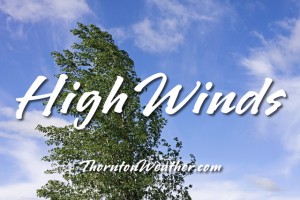
Northeastern Colorado closed out 2011 with pummeling high winds on New Year’s Eve. Wind gusts of tropical and hurricane storm strength slammed into the region causing damage and claiming one life.
In the Denver metro area gusts approaching 50mph were common while areas in the foothills and mountains to the west and on the plains to the northeast saw much higher speeds. Here in Thornton we recorded a maximum gust of 44.9mph in the predawn hours.
Following is a summary of the event from the National Weather Service:
Post-Storm Summary of the New Year’s Eve Windstorm
A fast moving upper level storm system, along with a deep low pressure system over Nebraska and high pressure building over Utah, combined to create a powerful windstorm across Northeast and North Central Colorado on December 31st. The high wind event began in the mountains after midnight Friday night, and then spread across the plains early Saturday morning. The height of the windstorm on the plains occurred around mid day when numerous gusts between 60 and 80 mph were reported.
The strong winds produced damage to fences and some roofs, and also knocked down trees resulting in power outages to approximately 19,000 residents. Some trucks were also blown off the road, and 1 fatality occurred due to a flying tree limb on U.S. Highway 36 north of Boulder.
Visibilities over the northeast corner of the state were also reduced significantly by a combination of blowing dust and blowing snow.
The following is a list by county of maximum wind gusts associated with this powerful windstorm…
Location Maximum Wind Gust
Adams…
Bennett 60 MPH
Front Range Airport 60 MPH
Arapahoe…
Deer Trail 59 MPH
Centennial 55 MPH
Boulder…
1 W Lyons 101 MPH
4 NW Boulder 84 MPH
Boulder 81 MPH
NCAR Mesa Lab 79 MPH
North Longmont 75 MPH
Boulder Municipal Airport 59 MPH
2 NNW Louisville 58 MPH
Broomfield…
Rocky Mountain Regional Airport 58 MPH
Clear Creek…
Berthoud Pass 94 MPH
Denver…
Buckley AFB 64 MPH
Denver International Airport 59 MPH
Douglas…
Centennial Airport 55 MPH
10 SSE Castle Rock 52 MPH
Highlands Ranch 50 MPH
Elbert…
10 E Parker 67 MPH
Elizabeth 55 MPH
Grand…
Berthoud Pass 94 MPH
11 N Kremmling 80 MPH
9 S Fraser 80 MPH
Jefferson…
3 SSE Pinecliffe 111 MPH
3 S Golden 86 MPH
Highway 72 and 93 Junction 79 MPH
National Wind Technology Center 77 MPH
3 NNW Morrison 76 MPH
4 S Rocky Flats 73 MPH
2 E Golden 67 MPH
2 E Northeast Lakewood 64 MPH
2 ENE Lakewood 64 MPH
3 W Conifer 62 MPH
Wheat Ridge 55 MPH
Larimer…
4 E Loveland 73 MPH
Natural Fort Rest Area 71 MPH
5 NW Fort Collins 67 MPH
3 NE Loveland 67 MPH
Wellington 63 MPH
4 E Fort Collins 63 MPH
Virginia Dale 62 MPH
Fort Collins 57 MPH
Lincoln…
3 W Cedar Point 80 MPH
Limon Airport 74 MPH
Logan…
Sterling Airport 73 MPH
Sterling 70 MPH
Crook 65 MPH
Morgan…
Wiggins 61 MPH
Park…
Kenosha Pass 79 MPH
Fairplay 77 MPH
Wilkerson Pass 58 MPH
Phillips…
4 E Haxtun 70 MPH
Holyoke 63 MPH
8 S Holyoke 62 MPH
Summit…
7 S Frisco 126 MPH
9 E Dillon 90 MPH
7 SSW Frisco 86 MPH
Washington…
Akron 75 MPH
Woodrow 73 MPH
5 NW Woodlin School 67 MPH
Weld…
4 ENE Eaton 80 MPH
3 NNW Cornish 79 MPH
2 NNW New Raymer 77 MPH
10 NE Pawnee Buttes 74 MPH
Briggsdale 72 MPH
9 NNE Briggsdale 72 MPH
7 N Rockport 70 MPH
Greeley Airport 67 MPH
4 ENE Severance 63 MPH
Eaton 63 MPH
1 N Greeley 62 MPH
6 E Berthoud 62 MPH
2 W Keenesburg 58 MPH
Milliken 56 MPH



